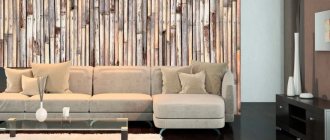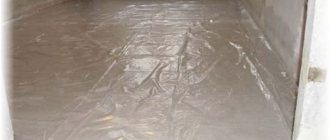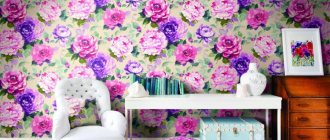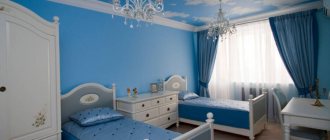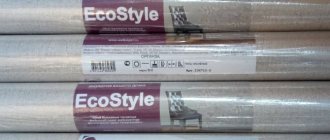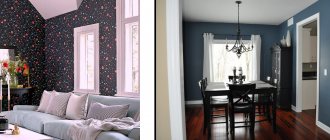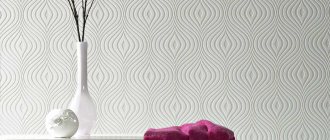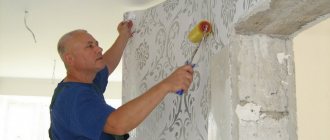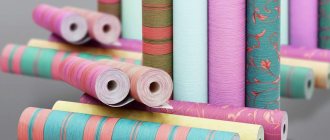MesterulManole
29106 0 9
MesterulManole June 12, 2017Specialization: many years of experience in finishing works of residential and office premises, dachas, country cottages, etc. Hobby: cycling in all its forms
Often cosmetic repairs are the need to disguise defects in old plaster
Curved walls are a problem in many old apartments. Of course, building surfaces can be leveled with plaster, but sometimes there is no time or money for this, and therefore it is easier to glue wallpaper for uneven walls, which will hide the relief. I will talk about which finishing materials to choose for visual alignment of walls. As a result, you will be able to hide the condition of the old plaster.
Is it possible to glue wallpaper to uneven walls: features
Uneven walls are one of the main problems when renovating an apartment. The flaws can be minor, noticeable only in certain lighting. There may be clearly visible irregularities that can only be corrected with the help of professional finishers. Such walls cannot be painted, liquid wallpaper or decorative plaster must be applied; this type of finishing will only highlight the imperfections of the wall. The only option that is suitable for decorating walls with uneven surfaces is to use wallpaper. They will help visually align the walls and partially hide imperfections.
What wallpaper to choose for uneven walls to hide unevenness and cracks
Irregularities on the walls will help hide the wallpaper:
- with a small pattern, for example, an ornament of plant elements, figurines of birds, animals;
- with an abstract design that does not have strict geometric shapes;
- with a textured pattern, any convex images, when properly glued, will make the wall more even. A convex pattern, both large and small, is suitable;
- with imitation of various types of plaster.
The pattern on wallpaper with a pattern should not be selected at the joints. This will increase the consumption of material and emphasize the unevenness of the wall if it falls under the joints of the strips.
Designations on the wallpaper: decoding
The resistance of the wallpaper to water and sun, strength, type of gluing and other characteristics are indicated by the symbols that are on each roll. Their meaning is easy to guess purely intuitively, but we will still give a decoding of the icons on the wallpaper.
We also give an example of wallpaper markings that you need to pay attention to. It is especially important that the batch number matches. Color may vary slightly between batches.
Which ones highlight the flaws in plaster?
In this case, you should not use rolls:
- with a strict geometric pattern, especially with vertical or horizontal stripes;
- with light or pastel shades, they will make recesses or protrusions on the walls much more noticeable;
- thin paper-based ones will highlight even small imperfections in the plaster;
- on a thin base with a geometric pattern. When pasted onto defects, the pattern will be deformed and attract attention;
- plain rolls of light colors, for example, sand, pink, light green.
The best wallpaper for the bedroom
In the bedroom it is better to stick to calm shades: blue, powdery, dusty pink, mint. Floral motifs or monogram patterns are suitable here, which will emphasize the richness of the furniture.
Rasch Lazy Sunday II
5
★★★★★
editorial assessment
100%
buyers recommend this product
Wallpaper Lazy Sunday II from Rasch is made in a delicate Provence style. Pastel colors combined with discreet patterns create a cozy space in the bedroom. The series includes options in small flowers, checks, polka dots, with drawings of trees and cute shepherdesses, as well as with imitation of old books. The manufacturer offers plain backgrounds for each of them.
The texture of all canvases imitates linen fabric. There are a total of 40 types of coatings in the collection, which allow you to create many interesting combinations. Non-woven backed vinyl is easy to glue, the joints remain invisible on the wall, and the linen texture hides imperfections in the rough surface.
Pros:
- 40 color options;
- unobtrusive color palette;
- pleasant flax texture;
- affordable price (1400 rubles per piece).
Minuses:
- are not always in stock.
The Lazy Sunday II collection lives up to its name, which translates as “lazy Sunday”. I want to lie in bed longer and look at the peaceful pattern on the wallpaper.
Fresco Empire Design
5
★★★★★
editorial assessment
98%
buyers recommend this product
Fresco textile wallpapers are created based on motifs popular in the 17th-19th centuries and add additional luxury to the interior. The series is made in natural colors, making it suitable for a bedroom in a classic or modern style.
Pastel colors, dark and light shades of brown match any furniture and look good in natural and artificial light. Large damask and neat floral motifs are complemented by monochrome backgrounds with a pleasant texture. There are a total of 35 types of wallpaper in the collection.
Pros:
- nice texture to match the fabric;
- base made of high-quality non-woven fabric;
- calm colors;
- rich patterns;
- 35 compatible options.
Minuses:
- high price (from 8,500 rubles per roll).
To wallpaper even a small room, you will have to pay a considerable amount for wallpaper. Despite the brand's reputation and high quality coating, many buyers prefer to look for cheaper Fresco analogues.
Affresco Dream Forest
4.9
★★★★★
editorial assessment
95%
buyers recommend this product
Affresco is a Russian factory that creates wallpaper in a seamless format. The Dream Forest collection is inspired by nature. The covers depict tropical motifs, flower fields, mysterious forests with animals in a light haze of fog, large flowers, branches of apple trees, magnolias, sakura and wisteria.
The series contains 35 drawings, each of which is presented in several shades. They fit best into interiors in the Rococo and Provence styles. The wallpapers look like huge illustrations. There are so many details in them that you want to look at them for a long, long time.
All frescoes and wallpapers from Affresco are drawn by artists by hand. At the factory, you can order seamless wallpaper up to 3.26x10.5 m in size. Any order can be made as a single sheet without joints or cut into rolls - the buyer chooses the option that is convenient for him.
Pros:
- seamless fabric;
- 35 options for plant patterns;
- detailed drawings;
- hand painted;
- Possibility to order your size.
Minuses:
- very expensive - from 19 thousand for a canvas measuring 320x240 cm.
Affresco Dream Forest is a seamless wallpaper that can be ordered in almost any size. In fact, these are real paintings, only without frames.
READ ALSO
13 best series of ceramic tiles
The thickest wallpaper for uneven walls
When choosing a suitable roll, you need to pay attention to the thickness of the material: the thicker it is, the better it will hide the imperfections of the walls.
The following wallpapers are suitable here:
- multilayer paper;
- non-woven fabric;
- vinyl, thanks to the coating they have a high density from 200 to 400 g/m2;
- from a natural base. They are made from plant materials, the most common being bamboo and cork. Thanks to their thickness and texture, they mask all the imperfections of the wall well. Can be used for one, the most problematic wall in the room.
Wallpaper made from natural materials is not cheap, but it does not emit harmful substances, is durable, and is easy to clean. Cork wallpaper provides sound insulation for the room.
Please note that the thicker the wallpaper, the more difficult it is to glue it. Therefore, if you have no experience in gluing wallpaper, you need to choose rolls with medium density.
Types of wallpaper by functionality
Each type of canvas has functional features that are important to consider when making repairs. Let's consider the types of products from the point of view of specific nuances.
Washable
Washable wall finishes mean that the wallpaper will not be damaged by wet cleaning. Manufacturers mark such products in a special way. One wave means that the surface should be wiped with a wet sponge, two - it is allowed to use non-aggressive cleaning compounds, three - care can be taken with any detergents. The range also includes particularly resistant materials that can withstand brushing and alkaline cleaning.
The class of washable wallpaper includes:
- Cork with wax coating.
- Acrylic.
- Metallized.
- Vinyl.
- Glass wallpaper.
A huge advantage of such products is the ability to use them in the kitchen, where the walls are often splashed with grease. To bring the finish back to its original form, simply do a damp cleaning.
Moisture resistant
Moisture-resistant wallpaper is a material that is suitable for finishing walls in rooms with high humidity. For example, in the bathroom. By the way, such canvases go well with wood and marble cladding.
Moisture-resistant variations are found among vinyl and non-woven fabrics. However, the most popular option is glass wallpaper. They are treated with a special impregnation, thanks to which the products do not peel off from the wall and are not susceptible to mold and mildew.
Important! Do not confuse this type of wallpaper with washable wallpaper. Just because the canvases are suitable for the bathroom, this does not mean that they can withstand regular wet cleaning. Be sure to read the labeling on the package before purchasing.
Anti-vandal
Anti-vandal wallpaper is a material that is not afraid of “attacks” from children and animals. The canvases are made from wear-resistant materials and coated with special compounds to improve properties. Such products are resistant to household acids, mechanical damage and temperature changes.
Types of wallpaper from this category: fiberglass, non-woven, laminated. Externally, they are not much different from ordinary ones, but are characterized by increased strength.
Sound-absorbing
Sound-absorbing wallpaper is most often made from synthetic velor, which looks like velvet. The canvas consists of two layers. The first is thick paper, the second is polyvinyl chloride fibers.
The main property of the material is its ability to muffle the sounds heard in the room. For this reason, this type of finish is often chosen for children's rooms.
For painting
Paintable wallpaper is a material that can be treated with various decorative compounds. Externally, the finish is unremarkable - it has a neutral shade. But the textures can be different - from a smooth surface to a pronounced relief.
What color hides unevenness?
Not only the texture and thickness of the wallpaper helps hide flaws in the plaster. Color is also important. It is better to choose rolls of dark colors, for example, with a dark background or with patterns of rich colors. Black and dark blue colors can hide flaws, but not many people will like a room with walls in such shades. It is better to use this color for one of the walls; for the rest, choose an option with a pattern that uses black or dark blue colors.
How to choose wallpaper for an apartment in different rooms?
However, choosing wallpaper for a specific room is not always so easy. To choose the most suitable ones, for example, moisture-resistant ones, you need to know the parameters that characterize individual wallpapers, and then choose the pattern you like from them.
Hallway
The hall requires wallpaper that is resistant to dirt, damage and temperature changes. In this case, non-woven vinyl wallpaper, or just non-woven wallpaper, is perfect. The designs of many of them are so beautiful that they disqualify other solutions in the duel for the most beautifully designed lobby.
Bathroom
Vinyl and fiberglass wallpapers are best used in the bathroom and kitchen due to their resistance to moisture, mechanical damage and getting wet. Such wallpapers can be washed even with detergents, because they are among the most durable.
Kitchen
Until recently, their samples were very limited. Today they are no different from other types of wallpaper. Therefore, they are increasingly replacing wall tiles. Using one roll, you can cover more than 5 square meters. they are certainly a cheaper solution than popular tiles, and the patterns on them are tempting with their richness of color and workmanship, such as those reminiscent of Moroccan tiles, which can replace the real thing.
Living room
For the hall, choose wallpaper that is not subject to rapid wear, for example, made from double paper or non-woven fabric; they are easy and quick to apply. In the living room, it is best to use trendy yet classic patterns with a timeless character. Any updated ornaments look great and fit both stylized and modern interiors. Wallpaper with a floral pattern and insects also brings a lot of lightness to the interior.
Bedroom
All types are suitable for sleeping in a room, for example acrylic, which have a relief structure that creates a pleasant and warm atmosphere in the interior, as well as the cheapest - paper, which will not be subject to damage or atmospheric changes in this room. Calm motifs and delicate shades are welcome here.
Children's
For the room in which a child will live, the most important thing is environmental friendliness, the durability of the wallpaper and its maintainability. The most ideal option here would be non-woven wallpaper for painting. They are inexpensive and environmentally friendly. However, the density is somewhat inferior to glass wallpaper. Wallpaper with fiberglass is also environmentally friendly and has good sound insulation. In addition, they are durable, difficult to damage and can be repainted more than once.
How to stick thick wallpaper on uneven walls
If there are visually not only defects on the walls, but also unevenness between the wall and the ceiling, you need to cut off the strips with a margin. After gluing and the glue has dried, the excess is cut off with a mounting knife to fit the ruler.
It is better to choose those dense wallpapers that have an overlap. This will allow you to do your work more accurately.
What glue is best for gluing?
Non-woven wallpaper is easy to paste, as the glue is applied to the wall. The strip is easily distributed over the wall surface and does not stretch due to wet glue.
You should use the type of glue recommended by the wallpaper manufacturer. It may seem that this is not economically profitable, since good material is not cheap. But this will ensure good adhesion of the strips to the wall. Typically, glue is sold in the form of a dry powder, which is diluted with water. When purchasing, you need to pay attention to the expiration date of the mixture.
Where to begin
First you need to do the preparatory work.
If there are cracks on the wall, then you need to remove the old material and prime the resulting depression. Then seal the crack with putty. Then apply a primer, it will strengthen the base and make it more convenient for gluing stripes. The drying time for the primer is indicated on the packaging. Typically, primers are used that form a film on the surface after drying.
Gluing non-woven or vinyl wallpaper is carried out in the following sequence:
- Using a building level, you need to draw a vertical stripe on the wall. The first strip must be strictly aligned with it. You can apply glue to the walls using a foam roller or a wide brush. This must be done carefully and as quickly as possible.
- Apply the strip and carefully align it from top to bottom. This can be done using a soft cloth or a clean foam roller. There is no need to forcefully smooth the canvas onto uneven surfaces, as this will only highlight the defects.
After gluing, unevenness may be visible at the junctions of the walls and ceiling. To hide them, use a ceiling plinth.
Features of gluing in corners
Gluing a solid canvas in a corner, especially if there are defects in the walls, will not work neatly. Pasting of internal corners must be done in the following sequence:
- measure the distance from the last glued strip to the corner;
- cut the wallpaper into two parts, the width of one should be equal to the measured size plus 5 cm;
- then you need to glue the strip so that a slight overlap goes around the corner. Excess wallpaper should be cut off at the corner with a sharp knife. If the angle line is not straight, then you need to use a ruler;
- on the other side, use a plumb line to draw a vertical line at a distance from the corner equal to the width of the remaining strip minus 2 cm. The drawn line will help to glue the wallpaper evenly;
- Apply glue to the wall, align the strip along the drawn line and carefully stick it on. This creates an overlap in the corner. It needs to be cut with a sharp knife.
Difficulties associated with gluing wallpaper to uneven surfaces
Instead of choosing what to cover with old plaster, try filling up large uneven areas
The installation instructions for roll coverings provide for preliminary preparation of building surfaces. If gluing is carried out without eliminating the relief, the following consequences are likely:
- The relief will be visible through the canvas - this is important for stretchy, smooth wallpaper.
- Sinuses form under the canvas, in the place of which it will swell and peel off. Such consequences are possible when using particularly dense, non-stretchy wallpaper.
Choosing the best option for masking irregularities
| Illustrations | What wallpaper hides uneven walls: 4 types of coatings |
Non-woven. Fully non-woven wallpaper is rarely found on sale, since this material is most often used as a backing for vinyl. However, non-woven fabric is good because it does not stretch, which means that the relief will appear to a minimum.
. | |
| Vinyl. This type of roll materials is produced on a non-woven or paper backing, on top of which vinyl coating is applied. It is advisable to buy vinyl coverings with a non-woven backing, as they have less stretch. The denser the canvas, the more likely it is that the relief will not show through it.
. | |
| Fiberglass. These are high-density coatings with a pronounced texture. Such materials are specially created in order to hide the imperfections of the surface being decorated. Thick fiberglass-based wallpaper is used for decorating office premises. But, if you don’t mind a minimalist interior, this finishing material will come in handy. To glue the fiberglass cloth you will need a special glue. | |
| Liquid . This category of finishing materials is not canvas in the traditional sense of the word; rather, it is decorative plaster. The coating as in the photo is made of dry filler and a binder. Decorative plaster is applied with a trowel. The advantage of the solution is its affordable price and the ability to level large reliefs up to 5 mm. |
Choice of texture and color design
| Illustrations | What wallpaper to glue on uneven walls: choosing a decorative design |
| Hot stamping . The coating has a pronounced relief texture. I recommend canvases that hide unevenness with a medium-sized pattern. | |
| Foamed . This is an excellent choice for distressed plaster, as the texture is disordered and there is no symmetrical pattern. This finish best hides unevenness. | |
| Embossed for painting . Despite the pronounced texture, the pattern is symmetrical, and therefore large relief will appear on such surfaces. | |
| Any coverings with a bright print without an ordered pattern . Suitable for masking large level differences. |
What not to glue to crooked plaster
| Illustrations | I absolutely do not recommend it for gluing uneven walls. |
| Paper single-layer coverings . Due to the small thickness, any even slight relief is visible on such surfaces. | |
| Any non-textured canvases with a large, ordered pattern . Such a coating cannot hide the relief. On the contrary, large irregularities will be clearly visible in bright light. | |
| Finishing materials are too heavy . Due to the unevenness of the plaster and the heavy weight, such coatings may fall over time. |
Recommendations for gluing
| Illustrations | How to hang wallpaper on uneven walls |
| We even it out as much as possible . It is clear that you decided to finish uneven surfaces, as there were good reasons for this. But, if the relief is more than 2 mm, try leveling it with putty. Believe me, it is not at all difficult and you can do it yourself. | |
| We prime. The key to quality gluing is a primer. Most often, uneven walls are plaster from which the old finish is crumbling. If the surface is crumbling, we treat it with deep penetration primers, which will penetrate the structure of the plaster and strengthen it. To ensure acceptable adhesion of roll coatings to old plaster, I recommend using film-forming, quick-drying primers. | |
| We do not iron the canvas, as when gluing it to smooth walls . If there are unevenness, smoothing the wallpaper as if gluing it to smooth plaster, we will only aggravate this relief. Therefore, we do not smooth them out, as usual with a rag, but roll them with a wide, dense roller. As a result, the roller will glue the canvas to the protruding areas of the relief surface and the wall will be visually smooth. |
Adviсe
For walls, it is better not to use sconces and other types of wall lamps, since the light from them in the evening will highlight all the shortcomings. The further the light source is from the wall, the less it will highlight imperfections.
Most defects, such as differences in height, minor depressions and protrusions, will only be noticeable in evening light. This must be taken into account when sealing cracks and small depressions.
If you have experience in finishing work, then it is advisable to correct obvious errors with plaster. For example, too large depressions and cracks will be very difficult to disguise even with thick wallpaper.
Thick wallpaper will cost more than thin wallpaper, but you should not skimp, as it will help hide imperfections.
When combining strips from different rolls, you need to think about the combination in advance. There should be repeating elements in two views, for example:
- the same texture with different color backgrounds;
- plain version and rolls with ornaments. In this case, the color of the plain fabric will be repeated in the ornament design;
- the same pattern in different colors. This can be a floral ornament on a pastel background or the same motif made on a dark background.
You should not choose wallpaper with a glossy, shiny surface; it is better to choose a matte version.
The glossy surface reflects light and highlights imperfections. You can paste wallpaper at home yourself, choosing rolls of high density. With their help, you can decorate small imperfections in the wall and irregularities at the junction of the wall and ceiling.
In conclusion
When choosing wallpaper directly in the store, you need to focus not only on how it looks in a roll - it is advisable to unroll it and see how it will look when placed on the wall. Always remember about combinations , so choose wallpaper that already matches existing furniture and decorative items, or they will then have to be combined with wallpaper. And if you are not sure what appearance the wallpaper should have, then it is better to opt for a plain version of a soft shade. And, of course, take into account the parameters of the room: different humidity and temperature require different wallpapers. Pay attention to the certification and batch number - it must be the same, otherwise the color may vary slightly.
The article was written for the site.
Tags:Wallpaper

